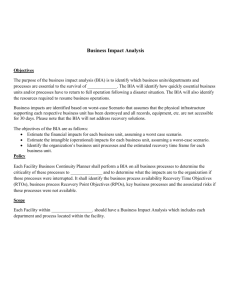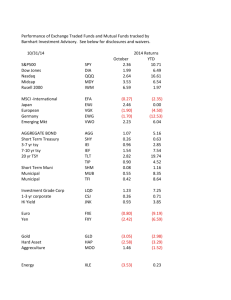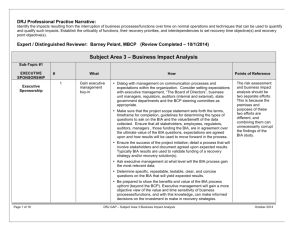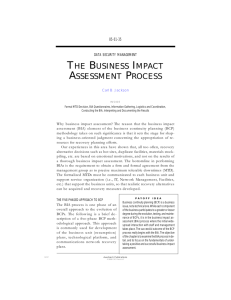BIA2
advertisement
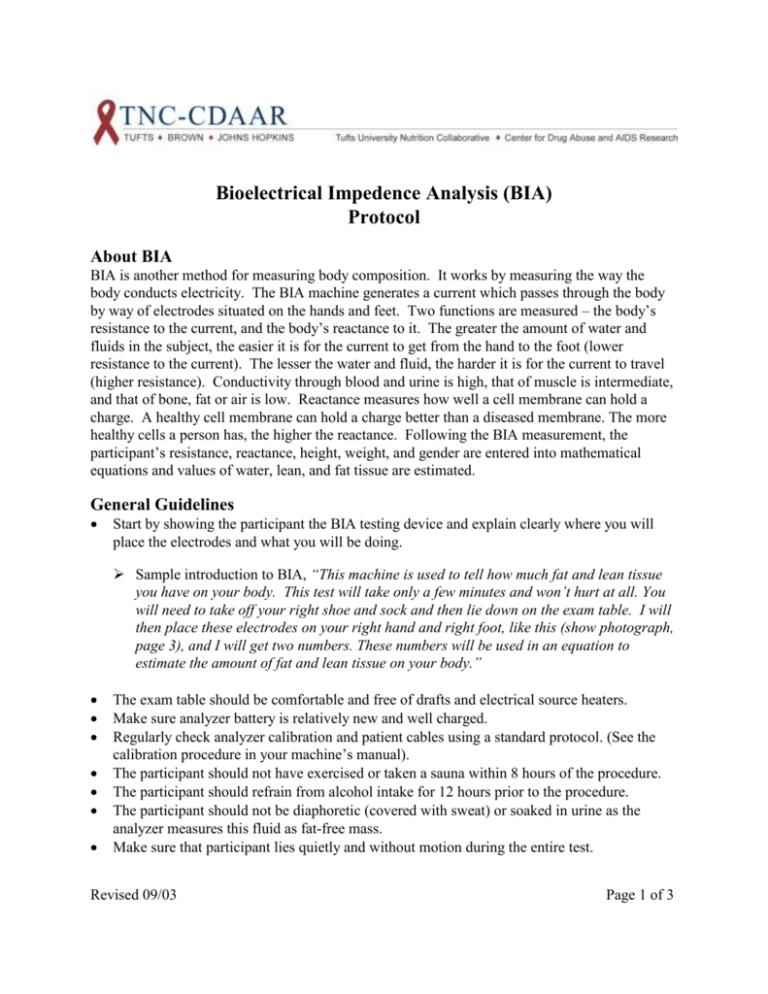
Bioelectrical Impedence Analysis (BIA) Protocol About BIA BIA is another method for measuring body composition. It works by measuring the way the body conducts electricity. The BIA machine generates a current which passes through the body by way of electrodes situated on the hands and feet. Two functions are measured – the body’s resistance to the current, and the body’s reactance to it. The greater the amount of water and fluids in the subject, the easier it is for the current to get from the hand to the foot (lower resistance to the current). The lesser the water and fluid, the harder it is for the current to travel (higher resistance). Conductivity through blood and urine is high, that of muscle is intermediate, and that of bone, fat or air is low. Reactance measures how well a cell membrane can hold a charge. A healthy cell membrane can hold a charge better than a diseased membrane. The more healthy cells a person has, the higher the reactance. Following the BIA measurement, the participant’s resistance, reactance, height, weight, and gender are entered into mathematical equations and values of water, lean, and fat tissue are estimated. General Guidelines Start by showing the participant the BIA testing device and explain clearly where you will place the electrodes and what you will be doing. Sample introduction to BIA, “This machine is used to tell how much fat and lean tissue you have on your body. This test will take only a few minutes and won’t hurt at all. You will need to take off your right shoe and sock and then lie down on the exam table. I will then place these electrodes on your right hand and right foot, like this (show photograph, page 3), and I will get two numbers. These numbers will be used in an equation to estimate the amount of fat and lean tissue on your body.” The exam table should be comfortable and free of drafts and electrical source heaters. Make sure analyzer battery is relatively new and well charged. Regularly check analyzer calibration and patient cables using a standard protocol. (See the calibration procedure in your machine’s manual). The participant should not have exercised or taken a sauna within 8 hours of the procedure. The participant should refrain from alcohol intake for 12 hours prior to the procedure. The participant should not be diaphoretic (covered with sweat) or soaked in urine as the analyzer measures this fluid as fat-free mass. Make sure that participant lies quietly and without motion during the entire test. Revised 09/03 Page 1 of 3 Bioelectrical Impedence Analysis (BIA) Protocol, continued BIA Procedure (using RJL Systems – Quantum II) Ask participant to remove their right shoe and sock. If, for some reason, the procedure must be done on the left side, then make a note of it and subsequently (next visits) always use the left side. Have participant lie on his/her back, on the exam table, with arms by his/her sides and arms and thighs not touching. Remove any jewelry on the electrode sites. Gently clean electrode sites with an alcohol wipe, particularly if the skin is moist or covered with lotion. Attach the electrodes as follows: (See photograph on page 3 for clarification). Wrist: Place on an imaginary line from the protruding bone of the wrist straight across to other side of wrist. Make sure the top of the electrode is toward the shoulder with the tab facing away from the body. Hand: Place on middle finger just above hand knuckle. Tab facing away from the body. Ankle: Place on an imaginary line between the protruding ankle bones straight across to other side of ankle. Make sure that the top of the electrode is toward the thigh with tab facing away from the body. Foot: Place just behind the middle toes above the knuckles (about 1 cm) of the right foot with tab facing away from the body. Attach the leads to the electrodes. (NOTE: The red lead goes to the hand, the black lead goes to the foot. The red clip on each lead always goes closest to the heart and black clip goes closest to the feet. Remember: “Red→Heart”) Turn the analyzer on and make sure the subject refrains from movement. When the measurements have stabilized, read and record the displayed Resistance (R), and Reactance (Xc). If the values fluctuate for either of the readings, use the lower value. Remove and dispose of the electrodes. BIA Protocol, continued Revised 09/03 Page 2 of 3 How Electrodes Are Placed on the Hand and Foot Revised 09/03 Page 3 of 3
